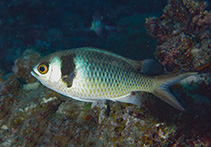| Family: |
Pomacentridae (Damselfishes), subfamily: Chrominae |
| Max. size: |
9.19 cm SL (male/unsexed); 8.74 cm SL (female) |
| Environment: |
reef-associated; marine; depth range 10 - 40 m |
| Distribution: |
Western Indian Ocean: restricted to the islands of Mauritius and Réunion. |
| Diagnosis: |
Dorsal spines (total): 8-8; Dorsal soft rays (total): 11-11; Anal spines: 2-2; Anal soft rays: 11-11; Vertebrae: 26-26. This species is distinguished be the following characters: D XIII,11; A II,10-11 (usually 11); pectoral rays 19-20 (usually 19); spiniform caudal rays 3; tubed lateral-line scales (17-19); gill rakers 7-8 + 20-22, total rakers 28-30; body depth 2.3-2.4 in SL. Colouration: when alive, mainly charcoal grey to dark greenish brown, whitish to yellowish anteriorly (behind pectoral fin) and ventrally; a broad black band behind head (or slightly overlapping opercle), from side of nape to just behind pectoral-fin base; cheek, opercle, and side of snout mainly white (except in yellow individuals), except black patch around upper margin of eye; iris yellow-orange; caudal fin mainly brown with darker band along dorsal and ventral edge of lobes; juvenile is bluish with prominent black band behind the head and bright yellow caudal lobes with yellow on upper lobe extending onto dorsal portion of caudal peduncle (Ref. 118302). |
| Biology: |
Usually found in habitats consisting of outer, seaward reefs at depths of about 10-40 m (Ref. 118302). |
| IUCN Red List Status: |
Not Evaluated (N.E.) Ref. (130435)
|
| Threat to humans: |
harmless |
Source and more info: www.fishbase.org. For personal, classroom, and other internal use only. Not for publication.

